
Home |
Up |
Prev |
Next |
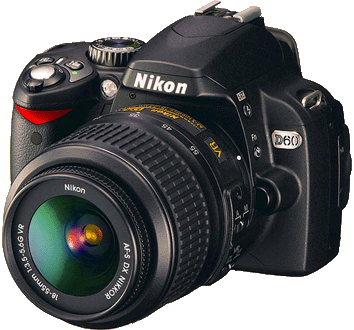
The Nikon D60
Finally I Found The Right Path!
Preamble
I bought my Nikon D60 after spending 5 months in hell trying find out why Canon SLRs couldn't produce properly sharp pictures. My local camera shop let me try out the D60 for a full day with the Nikon 18-55mm f/3.5-5.6 VR AF-S DX, and one morning's worth of shots gave me the joy I had been expecting. At last my shots were properly sharp. TACK SHARP! That's what I expect and that's what the Nikon delivered. You can bet I didn't let go of it!!!
That was more than a year ago now and I have done much photography and tried and bought a number of lenses since then. I think I am in a good position to critique this soon-to-be-obsolete entry level SLR. There are pros and cons, as there are with any camera, as I will detail, but in this case the pros greatly outweigh the cons.
Pros
Focus! The reason I bought this camera. The Multi-CAM530 three area SIR AF sensor does the job! It's got 3 detectors but you only need, (and want), one! Just give me one good AF sensor and I'm happy. If you can't refer focus what are you doing with a camera? Don't pay too much heed to studio focus tests such as the excellent Tim Jackson chart. These are useful to check for a systemic error but they don't give any idea of how the AF will perform in the real world. There is no substitute for educated scrutiny of real-world shots. If the focus is off then either you are an incompetent photographer or the camera or lens is either faulty or a dud. TACK SHARP folks, that's what you want. If your lens is in its sweet spot don't accept anything less. Nikon make good lenses and their quality control is good, (unlike Tamron's), even the kit lens gave tack-sharp results at f/8.

Huntsman Spider on my Wardrobe (sharp enough for you?) 100% crop - D60, Tamron 17-50mm f/2.8 DiII, f/5.6 50mm 1/60 sec ISO 100Yes there are occasional AF errors, but you must expect some with SIR AF1, the point is that there were not many. Distant landscapes will be generally OoF, but this is true for any camera. You should always use MF for landscapes. Just set the distance scale to a little before infinity and you're laughing!
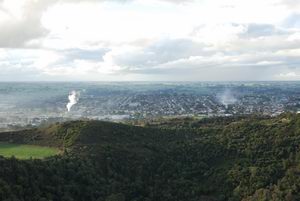
Mt Gambier landscape (click on the image to see the full shot) - D60, Tamron 17-50mm f/2.8 DiII, f/5.6 36mm 1/160 sec ISO 200, Manual Focus- Image Quality. The 10MP CCD sensor in this camera is very good. It may not be as sensitive as the CMOS job in the D90 and D300 but it produces beautifully sharp, contrasty and colourful photos (assuming you do your job properly).
10MPs is about right for an SLR. It is more than you need for any normal application even with substantial cropping, so there is no reason to ask for more. More pixels on the same sized sensor will only reduce image quality and degrade low-light performance. 10 is good!
Noise is just noticeable at ISO 200 and it becomes more so each stop up to ISO 1600, but it is not obtrusive until then. Even so, properly exposed shots at correct speed will give good and very useable results at ISO 1600.
Unfortunately Nikon chose not to provide a real ISO 3200 stop, which was rather condescending of them and probably intended as a trigger to force customers to upgrade. I wholeheartedly detest and deplore this rapine attitude on the part of manufacturers, whose intent is now to exploit their customers, rather than to make the best products they can. The "Boost" 3200 feature is simply push-processing in the digital domain. It is just ISO 1600 underexposed by 1 stop to give you more speed and then "pushed" up a stop later to correct the exposure. Of course you lose a stop of information by doing this, and although RAW theoretically gives you 1 extra stop of headroom the results are hopeless.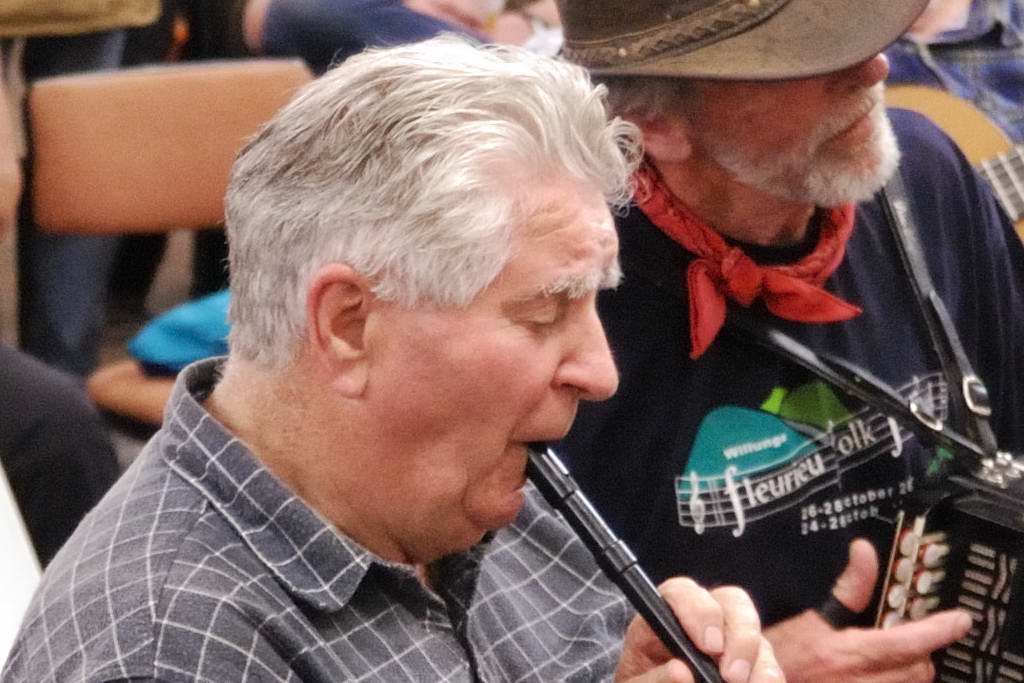
Bob Ballantyne at the NFF (100% crop) - D60, Tamron 17-50mm f/2.8 DiII, f/2.8 31mm 1/50 sec ISO 1600
This isn't a deal breaker though. Just forget about ISO 3200 and you'll be happy. If photographing people in low light is your main thing then this is probably not quite fast enough. I use an f/2.8 lens on this, which is generally enough for well lit parties, but for typically dim living rooms at night you're looking at exposures of 1/20 sec which is not really fast enough for people. You do really need at least another stop for such situations. You can get this by using an f/1.4 prime, (with its shortcomings), or by upgrading to a camera with a CMOS sensor, such as the D90 which claim to give a GENUINE extra stop of speed.
Or you could just use flash! You know, it's just possible they put that hot shoe there for a reason... Superb flash metering. Nikon are really good at this. Up the ISO to bring up the background, or lower it to enhance the foreground quality, it doesn't matter, the flash strength will be spot on.

Laura Young at the BBQ (fill flash) - D60, Tamron 17-50mm f/2.8 DiII, f/8 50mm 1/160 sec ISO 400- Brilliant Auto ISO facility. It's a simple idea but it really works! You can set the maximum auto ISO level so that you get the quality you want. There's more to it than this though because you can set your minimum shutter speed as well, so that when you're in Aperture Priority mode the auto ISO will trade off speed before it trades off ISO.
But what really makes it BRILLIANT, (and the condescending bastards don't document this), is that in Programmed Auto mode you can set the normal ISO while you have auto ISO active and it will then use that as the cross over point between trading off ISO and aperture. Absolutely brilliant and it really works!!!
Here's what happens: suppose you are in a well-lit room at night. You are filming people and have a minimum shutter speed of 1/60s. Some shots require maximum speed, ie ISO 1600 and f/2.8, most shots are ISO 800 and f/2.8 and some are ISO 400 and f/2.8. You want to shoot f/4 if you can but you can't be continually fiddling with the aperture and ISO buttons. No problem, you set the Max ISO to 1600 and the Min exposure to 1/60s in the Auto ISO menu. You then activate the Auto ISO, switch to P mode and set the normal ISO parameter to 800. Auto ISO will then hold the exposure at 1/60s and the aperture at f/2.8 and adjust the ISO between 800 and 1600 to get the correct exposure, however, once the light is good enough to drop the ISO level below 800, Auto ISO holds the ISO at 800 and closes the aperture! So instead of getting ISO 400 and f/2.8 you get ISO 800 and f/4. FANTASTIC!!!
So why don't they document this? The words "fucking idiots" come to mind... - Responsive. Well I guess all SLRs these days are quick and this one doesn't disappoint. You see the shot, hit the shutter button, and unless the lens needs to move significantly the shot is captured. It's very intuitive: the way photography should be.
Cons
- 4 way controller moves the AF point. This is almost a disaster! All you need to do is accidentally touch the 4 way controller in shooting mode and the AF point will no longer be in the centre. God knows what you will be focusing on then! Yes, there is a display in the viewfinder to alert you, but that's not the point. When I'm shooting I'm concentrating on the subject, I can't be continually scanning my parameters, I need to be able to set them for the environment and then forget about them. It's a disaster to walk out of a shoot and discover the damn AF point has been moved! Fortunately this has happened only once or twice, but it's not really acceptable Nikon!
I don't get the point of multi-area AF anyway. You don't want the camera deciding where the focus should be do you? Surely all serious photographers are just gonna use the central point and turn off the others aren't they? As for 50 point units, what a joke! Accurate AF requires as many high sensitivity SIR pixels as possible, if you spread them around multiple areas the result per area is gonna be poor. Why not put all 500 pixels into a single, super high quality SIR point bang in the middle and be done with it!
You've got the 4 way controller, so use it for something important. Using it for AF point control is just dumb. What kind of fool stands there with the shot framed, fiddling with the 4 way? I mean, "come on!", the shot would be long gone. There's no better way than to refer the focus to the central point. Surely we all know this??? Canon use the 4 way to set the important parameters such as WB, ISO etc in one click. No ifs or buts, this is the best use of the controller. Just do it Nikon!
Canon also let you turn off the unwanted AF points. Surely it wouldn't be hard to add this to the menu??? - Timer mode lasts for 1 shot only. What's the point of this Nikon? If you set up for 1 timer shot chances are you're gonna want to do more. But every time you've got reset to timer mode. Tedious!
- RAW + JPG only saves low quality JPG. More nerfing the product to force people to upgrade. What a pain Nikon, there's no need for this.
RAW review displays only a thumbnail. I know that other cameras exhibit the same problem here but really, it's not good enough. You're out in the field and you need to know if you've got the shot so you review. It looks fine zoomed out, but you need to check the sharpness so you zoom in. Unfortunately it's only a thumbnail so you can't really tell. There's plenty of memory and plenty of processor speed now, so either decode the RAW on the fly or save a full size jpg as part of the RAW package.
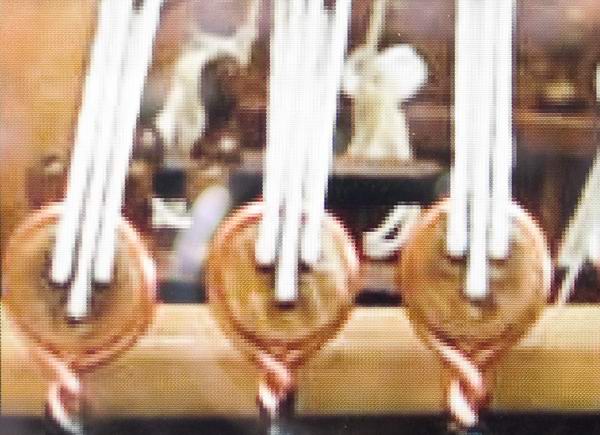
The LCD display at full zoom - in focus? You can't tell.- ISO not displayed in the viewfinder. It's only an entry level unit they cry! Yeah well I want it anyway!
- LCD shooting display not designed for photographers. For a start the default display is a disaster! Who needs most of the screen real estate taken up by a stupid diaphragm icon? There's only so much screen real estate, let's not waste it. You can change to a more sensible display that shows you what you need to know, but many of the most important parameters, such as ISO and WB are in small font with low contrast and off to the side. Why should the stupid colour mode and beep icon get centre stage? Why should the number of shots left be largest icon on the screen?
It's just an irritant really, rather than a deal breaker, but Canon can get it right, why can't Nikon?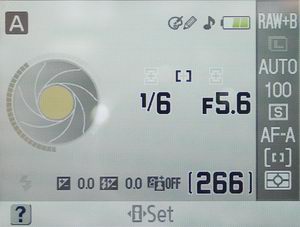

"Graphic" shooting display (default) "Classic" shooting display - Auto White Balance will usually be wrong. This is not just a problem with this camera, it is true of every camera that I have used. When you think about it, this is not surprising. How can a camera know what the light source is? All it can do is make a guess from the objects in the frame. Unless you're under a blue sky that guess will likely be wrong.
You can solve this problem like every other decent photographer, by manually adjusting the white balance, either at the time or more likely later when post processing your RAW shots. This is one of the main reasons why you must shoot RAW. - Exposure bias adjustment is awkward. Yes it's possible to do with one hand, but it's awkward, my index finger doesn't want to go there. There are too many buttons as it is. A single EV button directly behind the shutter release would be better than having one button on each side. You can just chuck the stupid Dynamic Range button!
- No screw drive for older lenses. This is not the problem now that it would have been some years ago when Nikon had only a few AF-S lenses. From memory, ALL the new Nikon lenses are AF-S (ie equipped with a built in silent wave motor) and for these a screw drive body is superfluous. Most of the niches in Nikon's lens panoply now contain AF-S lenses and the rest will no doubt be filled in the next few years. 3rd party manufacturers such as Tamron and Sigma have reissued their previously screw-drive-only Nikon mount lenses with built in motors to suit Nikon's entry level SLRs. The screw drive is a dead beast and I predict that in a decade even the top Nikon SLRs will no longer have it.
- No contrast detect AF. True, this could be useful feature, but considering how slow this is on contemporary rivals, I would say it's not worth having at this point in it's development. If you have truly accurate SIR AF, as you do with this beastie, then why do you need contrast detect?
- No Exposure or WB bracketing. Another case of nerfing the entry level. Nikon could have easily put these in at no extra cost to them but they insist on playing their damn market manipulation games. Still, if you shoot RAW you don't need these. You can easily and perfectly adjust these in PP with RAW even beyond 1 stop so what's the point of them? All they do is clog up your memory card and prolong the PP. If you don't shoot RAW then you're obviously not interested in getting the best result.
- No video recording ability. Well since there is no contrast detect AF, (ie no mirror up record ability), there can't be video, now can there? Anyway, other cameras of this vintage that do offer some sort of video ability do so in a fairly dodgy form. For example the D90 can't alter focus once the filming is begun. Although video facility of the type seen in modern compacts would be occasional useful, I feel that it will always be something of a gimmick.
- Tends to under-expose. This typically happens on overcast days, often by around 2/3 stop. This is better than over-exposing though, especially if you shoot RAW, where you can easily correct it. You can always adjust the bias anyway so it's not a major problem.
- ViewNX is not as good as DPP. Another area where Canon is better. DPP is faster, simpler and more powerful. In particular, DPP incorporates lens profiling, which is just magic if you've ever used it. Again Nikon want to get you to shell out for CaptureNX. It's just exploitation. Isn't it enough that we buy the camera???
This is not to say that ViewNX is a bad product. I use it and even quite like it, but I would like it more if it did fractional rotate, crop, red eye removal and lens correction.
Neither Good Nor Bad
- Retouch Menu. Why is it there? Is there anyone that seriously processes their shots in camera??? I guess if there were no other way, but we've all got computers haven't we? Haven't we?
- Dynamic Range Enhancement. The idea has merit, but the shots I have taken using this feature have been so horrible that I threw them out. If you want to fiddle with the dynamics shoot RAW and post process. You get another 2 stops of detail with RAW so you can bring out shadow or cloud detail or boost the midrange in your image processor of choice and be in full control. It's silly to try and do it in camera!
Still, you can simply ignore it. The camera is quite small. Is this a problem? It sits quite nicely in my hand, (and my hands are moderately large), but only gripped my middle 2 fingers. My little finger sits under the camera body and my index finger is on the shutter release. Perhaps this is not ideal but it seems to work quite well. I guess it would better suit a woman's hand but I'm not complaining. There are advantages to it being small: it is less conspicuous, less cumbersome and less heavy.
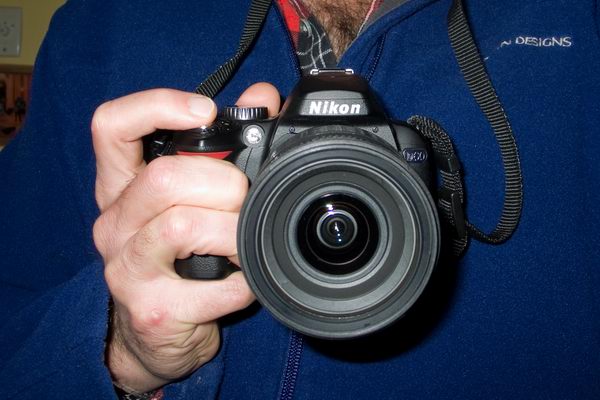
The D60 in my hand
Conclusion
The D60 is a little ripper! Yes it has a raft of cons but these are all irritants rather than deal breakers. The point is that it is responsive in the hands and takes great pictures. If you are a competent photographer you can expect pictures that are tack sharp, and generally well exposed with accurate colour. What more do you want?
I sold my Canon 400D and deserted the Canon cause for this little beastie, a decision I have not for one instant regretted. The truth is that the Canon outperformed the Nikon in all areas but one: Focus. In the end there is only one thing that REALLY matters: the final image. Forget the cons, the D60 delivers where it counts!
I have taken over 6,000 pictures with this camera and I can heartily recommend it. The shots speak for themselves.
With 3 lenses in the Nikon mount and counting I expect my next SLR will also be a Nikon. Yes, I'm a Nikonian now!
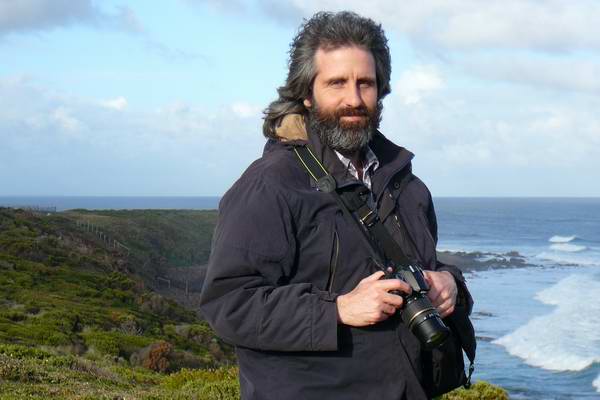
The Author at Pt Danger, D60 in hand - photo: Robin Young
- Secondary Image Registration (as opposed to the contrast detection AF used in compacts).